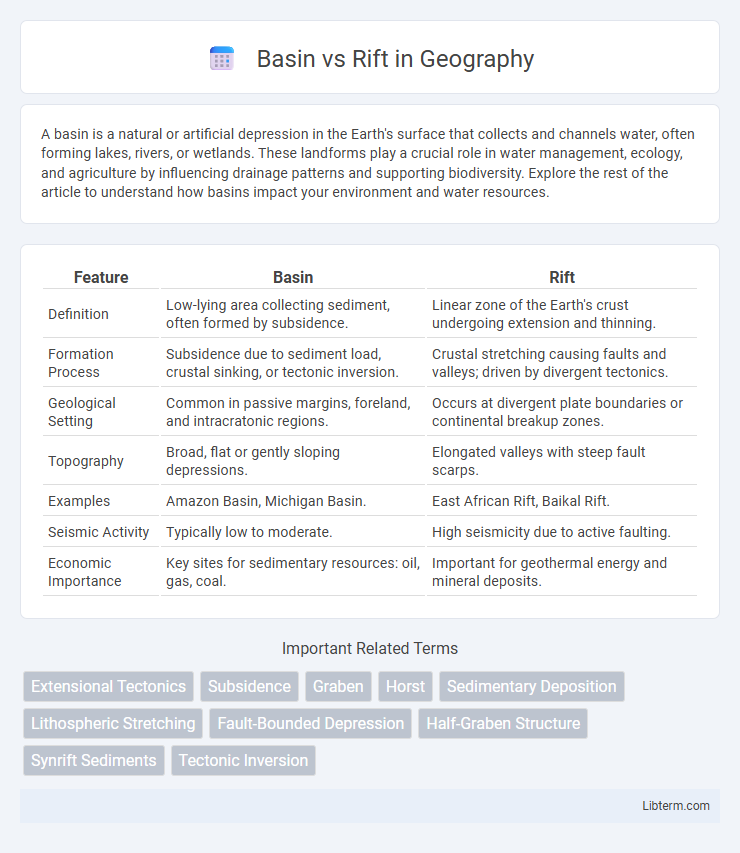A basin is a natural or artificial depression in the Earth's surface that collects and channels water, often forming lakes, rivers, or wetlands. These landforms play a crucial role in water management, ecology, and agriculture by influencing drainage patterns and supporting biodiversity. Explore the rest of the article to understand how basins impact your environment and water resources.
Table of Comparison
| Feature | Basin | Rift |
|---|---|---|
| Definition | Low-lying area collecting sediment, often formed by subsidence. | Linear zone of the Earth's crust undergoing extension and thinning. |
| Formation Process | Subsidence due to sediment load, crustal sinking, or tectonic inversion. | Crustal stretching causing faults and valleys; driven by divergent tectonics. |
| Geological Setting | Common in passive margins, foreland, and intracratonic regions. | Occurs at divergent plate boundaries or continental breakup zones. |
| Topography | Broad, flat or gently sloping depressions. | Elongated valleys with steep fault scarps. |
| Examples | Amazon Basin, Michigan Basin. | East African Rift, Baikal Rift. |
| Seismic Activity | Typically low to moderate. | High seismicity due to active faulting. |
| Economic Importance | Key sites for sedimentary resources: oil, gas, coal. | Important for geothermal energy and mineral deposits. |
Understanding Basins and Rifts: Definitions
A basin is a low-lying geological depression where sediments accumulate over time, often forming valuable natural resources such as oil and gas. A rift is a structural fracture or zone where the Earth's crust is pulling apart, leading to the creation of new basins and volcanic activity. Understanding the distinct formation processes and geological features of basins and rifts is crucial for exploring sedimentary deposits and tectonic evolution.
Geological Formation Processes: Basin vs Rift
Basins form primarily through subsidence caused by tectonic compression, sediment loading, or crustal cooling, creating low-lying areas that accumulate sediments over time. Rifts develop as a result of extensional tectonics, where the Earth's lithosphere is pulled apart, leading to faulting, crustal thinning, and the formation of a linear valley. These distinct geodynamic settings dictate sedimentary patterns and structural features unique to basins and rift zones.
Key Structural Differences Between Basins and Rifts
Basins are typically characterized by broad, subsiding areas where sediments accumulate due to downwarping of the Earth's crust, whereas rifts feature extensive crustal extension and thinning leading to faulting and formation of elongated valleys. Rift zones exhibit normal fault systems and active tectonic stretching, while basins often show passive sedimentary infill without significant fault displacement. The structural distinction lies in basins being primarily depositional settings, whereas rifts represent active tectonic zones with divergent plate boundaries.
Types of Basins and Rifts
Sedimentary basins primarily include foreland, intracratonic, and rift basins, each formed by distinct tectonic processes and sediment accumulation patterns. Rift basins specifically develop through extensional tectonics, where the Earth's crust is pulled apart, creating distinct fault-bounded troughs filled with sediments. Foreland basins form adjacent to mountain belts due to crustal loading, while intracratonic basins develop within stable continental interiors, often unrelated directly to plate boundary interactions.
Tectonic Settings: Where Basins and Rifts Occur
Basins commonly form in diverse tectonic settings such as passive continental margins, intracratonic regions, and foreland areas where subsidence accumulates sediments. Rifts develop primarily in extensional tectonic environments characterized by crustal thinning and faulting, often marking the initial stages of continental breakup. The distinction lies in basins being depositional features in various tectonic regimes, whereas rifts represent active zones of lithospheric stretching.
Sedimentation Patterns in Basins and Rifts
Sedimentation patterns in basins typically exhibit thick, continuous layers of fine-grained sediments due to stable subsidence and low energy environments, promoting gradual accumulation over time. In contrast, rifts display more variable sedimentation with coarse clastic deposits and rapid facies changes caused by active tectonics and episodic subsidence, leading to heterogeneous stratigraphy. These differences influence reservoir quality and stratigraphic traps in hydrocarbon exploration within sedimentary basins and rift systems.
Economic Importance: Resources in Basins vs Rifts
Basins often contain abundant sedimentary deposits rich in hydrocarbons such as oil and natural gas, making them prime targets for energy extraction industries. Rifts are significant sources of geothermal energy and mineral resources, including metals like copper and gold, due to their tectonic activity and associated magmatism. Both geological structures play critical roles in global resource supply but differ in the type and accessibility of their economic resources.
Famous Examples of Basins and Rifts Worldwide
The Great Artesian Basin in Australia and the Amazon Basin in South America rank among the most famous sedimentary basins globally, known for their vast groundwater resources and rich biodiversity. The East African Rift Valley, part of the larger East African Rift System, and the Rhine Graben in Europe stand out as iconic rift valleys formed by tectonic plate divergence. These geological structures are crucial for understanding sediment deposition in basins and tectonic activity in rifts, influencing landscapes, ecosystems, and natural resource distribution.
Environmental Impacts of Basin and Rift Evolution
Basin evolution significantly influences sediment deposition patterns, groundwater recharge, and wetland formation, which directly affect local biodiversity and water quality. Rift formation triggers volcanic activity and tectonic shifts, causing habitat disruption, altered hydrology, and increased greenhouse gas emissions from exposed geological formations. Both processes reshape landscapes but differ in their scales and types of environmental stresses, with basins often promoting ecological stability while rifts induce dynamic environmental change.
Comparing Basin and Rift Features: A Summary
Basins are large, low-lying areas often filled with sediment, typically formed by subsidence or sediment accumulation, while rifts are linear zones where the Earth's crust is being pulled apart, creating faults and valleys. Basins usually have gentle slopes and are filled with layered deposits from rivers, lakes, or oceans, whereas rifts exhibit steep fault scarps and active tectonic deformation marked by volcanic activity and seismicity. The key difference lies in their formation processes: basins result mainly from crustal sagging or sediment loading, whereas rifts form due to extensional tectonics causing crustal thinning and breakage.
Basin Infographic

 libterm.com
libterm.com